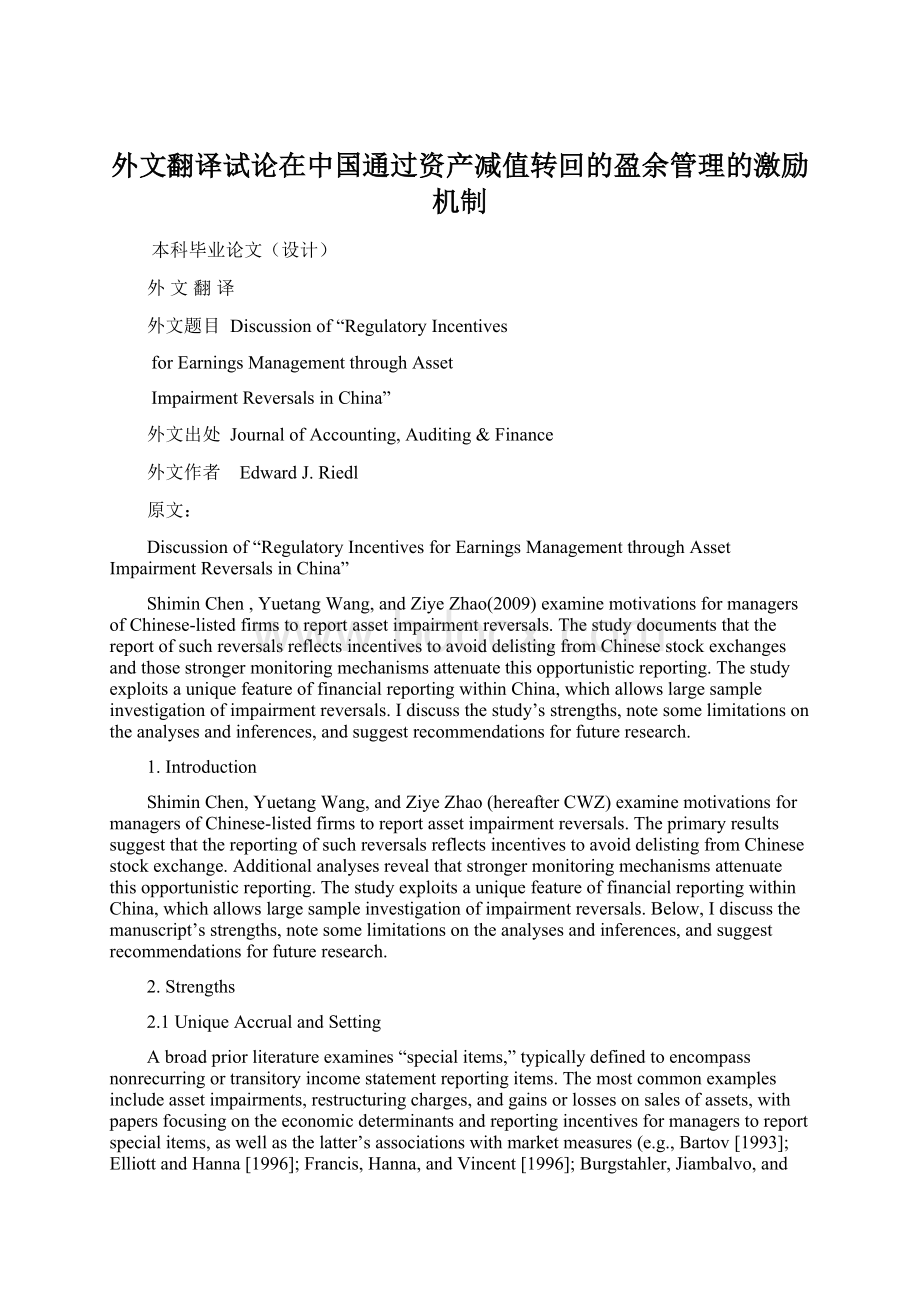外文翻译试论在中国通过资产减值转回的盈余管理的激励机制.docx
《外文翻译试论在中国通过资产减值转回的盈余管理的激励机制.docx》由会员分享,可在线阅读,更多相关《外文翻译试论在中国通过资产减值转回的盈余管理的激励机制.docx(9页珍藏版)》请在冰豆网上搜索。

外文翻译试论在中国通过资产减值转回的盈余管理的激励机制
本科毕业论文(设计)
外文翻译
外文题目Discussionof“RegulatoryIncentives
forEarningsManagementthroughAsset
ImpairmentReversalsinChina”
外文出处JournalofAccounting,Auditing&Finance
外文作者EdwardJ.Riedl
原文:
Discussionof“RegulatoryIncentivesforEarningsManagementthroughAssetImpairmentReversalsinChina”
ShiminChen,YuetangWang,andZiyeZhao(2009)examinemotivationsformanagersofChinese-listedfirmstoreportassetimpairmentreversals.ThestudydocumentsthatthereportofsuchreversalsreflectsincentivestoavoiddelistingfromChinesestockexchangesandthosestrongermonitoringmechanismsattenuatethisopportunisticreporting.ThestudyexploitsauniquefeatureoffinancialreportingwithinChina,whichallowslargesampleinvestigationofimpairmentreversals.Idiscussthestudy’sstrengths,notesomelimitationsontheanalysesandinferences,andsuggestrecommendationsforfutureresearch.
1.Introduction
ShiminChen,YuetangWang,andZiyeZhao(hereafterCWZ)examinemotivationsformanagersofChinese-listedfirmstoreportassetimpairmentreversals.TheprimaryresultssuggestthatthereportingofsuchreversalsreflectsincentivestoavoiddelistingfromChinesestockexchange.Additionalanalysesrevealthatstrongermonitoringmechanismsattenuatethisopportunisticreporting.ThestudyexploitsauniquefeatureoffinancialreportingwithinChina,whichallowslargesampleinvestigationofimpairmentreversals.Below,Idiscussthemanuscript’sstrengths,notesomelimitationsontheanalysesandinferences,andsuggestrecommendationsforfutureresearch.
2.Strengths
2.1UniqueAccrualandSetting
Abroadpriorliteratureexamines“specialitems,”typicallydefinedtoencompassnonrecurringortransitoryincomestatementreportingitems.Themostcommonexamplesincludeassetimpairments,restructuringcharges,andgainsorlossesonsalesofassets,withpapersfocusingontheeconomicdeterminantsandreportingincentivesformanagerstoreportspecialitems,aswellasthelatter’sassociationswithmarketmeasures(e.g.,Bartov[1993];ElliottandHanna[1996];Francis,Hanna,andVincent[1996];Burgstahler,Jiambalvo,andShevlin[2002];Riedl[2004]).CWZaddstothisliteraturebyexamininganuncommonaccrual:
thereversalofassetimpairments.Firms’abilitytoreportthistypeofaccrualisfairlyuniquetotheChinesesetting:
SuchreversalsaregenerallyprohibitedunderU.S.GenerallyAcceptedAccountingPrinciples(GAAP);areallowedincertaincircumstancesbutinfrequentlyreportedundertherelevantinternationalaccountingstandards;andhavebeenallowedundercertaindomesticaccountingstandards(e.g.,revaluationswithinAustralia),thoughtypicallyreporteddirectlytoequity(andthuswithoutanyassociatedeffectonnetincome).Asaresult,priorresearchhasexaminedonlylimitedcircumstancesofreversalsofprioraccruals,focusingonreversalsofrestructuringcharges(Moehrle[2002])andassetrevaluations(e.g.,Easton,Eddey,andHarris[1993]).Furthermore,thefactthattheCWZstudyissetinChinareflectsthegeneralmanufacturingbase(andthushighlevelofreportedtangibleassets)ofthebroadeconomy,thusaffordingasubstantialnumberofobservationsandpowertoconducttheanalyses.
2.2ClearlyDefinedRegulatoryIncentives
CWZexploitstheexplicitandwell-definedregulatoryincentivesthatlistedChinesefirmsfacetoavoidreportinglosses.Specifically,thestudyhighlightsthatfirmsreportingtwosuccessiveyearsofaccountinglossesreceiveaparticulardesignationonthetickersymbolthatdenotestheriskofdelisting;reportingthreesuccessiveyearsoflossesleadstodelisting.WhilepriorresearchprovidessomeevidenceconsistentwithU.S.firmsbeinglesslikelytoreportimpairmentstoavoiddelisting(e.g.,BeattyandWeber[2006]),thethresholdsarespecifictoparticularstockexchangesandlessclearlydefined.Furthermore,becausetheUnitedStatesgenerallyprohibitsfirmsfromreversingimpairments,thelinkbetweentheobservedreportingchoiceandregulatoryincentivemustbeinferredfromtheabsenceofareportedimpairment.Insomecontrast,thecurrentsettingallowsastrongcouplingbetweenaclearlydefinedregulatoryincentive(delistingduetoastringofreportedlosses)andanobservedincome-increasingaccrualwithsubstantialdiscretion(theimpairmentreversal).
2.3KeyConstructsSubjecttoLowerMeasurementError
Priorresearchexaminingspecialitemstypicallyemploysextensivehand-collectionofdatafromearningsannouncements,annualreports,footnotes,andothersourcedoucuments.1Furthermore,thepresentationofspecialitemsisnotwelldefinedintheaccountingstandards,leadingtolargevariationinthelevelofdetailanddisclosure(e.g.,disclosurebylargerversussmallerfirms).Thus,priorstudiesofspecialitemsbeartheburdenofpotentiallynoisymeasurementintheexperimentalconstruct.InthesettingofCWZ,ChineseGAAPrequirestabularpresentationofanyimpairmentreversals.Asaresult,thisaffordsanunusualopportunitytoreducemeasurementerrorarisingfromhand-collectionandcodingofdata.2
1.Compustatbeganprovidingdecomposedcategoriesofspecialitems(e.g.,write-offs,restructuringcharges)asof2002;previously,specialitemswereavailableelectronicallyonlyinaggregateform.Thus,hand-collectionofdataprimarilyaffectsstudieswithsampleperiodspreceding2002.
2.Themeasurementerroralludedtointhisparagraphisthecodingofthedatabytheresearcher.Thisisdistinctfromanymeasurementerrorarisingbythereportingfirmmanagementduetoerrorintheestimationoftheobservedeconomicevent,aswellaspotentialbiasinthereportingoftheamount.
3.Limitations
3.1RegulatorsAssumedtobeNaïveUsers
TheresultsofCWZsuggestthatfirmsaremorelikelytoundertakeimpairmentreversalswhenthereareincentivestoavoiddelisting.WhatisunclearistheroleofChineseregulatorsinevaluatingreportednumberstoassessdelistingrequirements.Specifically,doregulatorsreviewreportedamountsorsimplyacceptreportednumbersasgiven?
Dotheyhavethefacilitytodetectlikelymanipulation?
Dotheyimposepenaltiesforclearviolationsofthedelistingrequirements?
Overall,towhatdegreetoassumethatregulatorsarenaïveusersofaccountinginformation,acceptingfiguresasreported.Thisseemsparticularlyatoddswiththerelativehightransparencyoftheimpairmentreversalsunderinvestigation(e.g.,owingtotherequiredtabularreportingformat),aswellasmanyofthereversalsrelatingtorelativelyeasytovalueshort-termassets(seeSection3.3).Thissuggeststhatregulatorscaneasilyascertaininstancesinwhichthisaccrualmovesfirmsfromviolationtononviolationowingtoaclearlydefinedthreshold(negativeearnings;seeSection2.2).Thus,weareleftwonderingwhattherealevaluativecapacityisforregulatorsinthissetting,andwhetherthisaccrualisaneffectivemechanismthatallowsmanagerstoavoidthiscontractingcost.
Itispossible,however,thatmanagersofthesamplefirmssimplyperceivethatregulators(withsomeprobability)willneitherdetectnorpursueadjustmentstotheseaccruals,regardlessofregulators’actualdetectionorenforcementcapabilities.Ifmanagerswerebehavinginthismanner,thiswouldlikelymanifestinfirmsreportingimpairmentreversalstoavoiddelistingasobservedinthecurrentstudy,butalsoinsomesubsetoffirmshavingthereversalssubsequentlydisallowedbyregulators(andpotentiallydelistedasaresult).IdiscussthispossibilityinSection4.
3.2WhatAretheExplicitCoststoDelisting?
Whiledelistingwouldintuitivelyseemtobeacostlyoutcomeforagivenfirm,thecurrentstudyislessclearonidentifying(andexploiting)whatthespecificcostsmaybe.First,itisunclearthatsubstantialhurdlesexistforfirms’sharestobe“relisted.”Related,priorliteraturehasnotestablished(inthissetting)thatfirmspreviouslydelistedfacesubstantialincrementalcosts(e.g.,highercostsofcapital)uponreentryintothecapitalmarkets.Second,themanuscriptwouldbenefitfrominsightsintotheeconomicreasonsmanagersofthesefirmswishtoavoiddelisting.Suchreasonscouldvaryacrossfirmsandcouldprovideanadditionalvenueforexamination.Forexample,docertainfirmsrequireadditionalcapital(whethertofundgrowthormaintainoperations),andthusavoiddelistingtoallowsubsequentstockissuances?
Dotheownersofcertainfirmsattempttocashouttheirholdings,andthusavoiddelistingtoallowsubsequentdisposalofshares?
Arethereexpectationsoflitigationcostsarisingfromshareholderlawsuitsduetodelisting?
Furtherevidenceonthesereasonswouldprovidemoreexplicitlinksonthemotivationstoreportthisaccrualtoavoiddelisting.
3.3ReconcilingtheReversalstotheNatureoftheAssets
CWZprovidesdetailonthedistributionofassetsforwhichimpairmentreversalsarereported(seeTable2).Itisinterestingthatasubstantialportionofthesamplereversalsareforassetstypicallydefinedasshort-termassets.3Thisraisestwoissues.First,assumingthattheimpairmentswerereportedinthepreviousfiscalcycle(potentiallytheprioryear),andbecausesuchassetsshould,bydefinition,beconvertedintocashduringtheensuingyear,itappearsoddthatimpairmentsfortheseparticularassetscouldbereversedwithvaluesaddedbacktothebalancesheetasunrealizedreversalsinthecurrentyear.Thatis,howdotheseassetsremaincategorizedasshort-termassets?
Second,andmoreimportant,thesetypesofassetsarefarmorelikelytohaveobservablemarketvalues,owingtotheirshortertermand(likely)